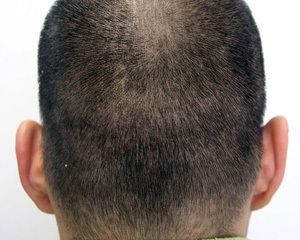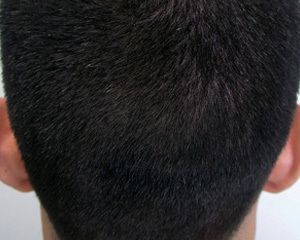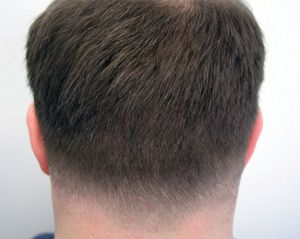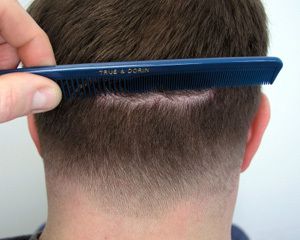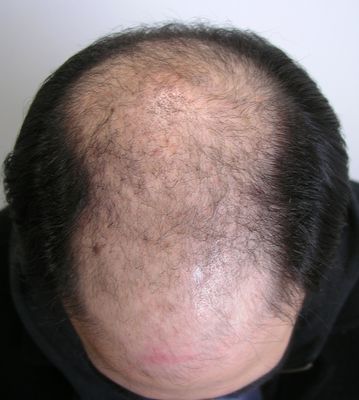HAIR TRANSPLANT & HAIR LOSS FAQs
Common Hair Loss Questions
Drs. Robert J. Dorin and Robert H. True believe informed patients experience the most satisfaction in their results. Here, we provide short answers to some common hair loss questions we hear from patients visiting us at our offices in Manhattan, NYC, and communities throughout greater NYC.
-
What will the donor site look like?
Years of research and experience in both FUE and follicular unit transplantation (FUT) not only allows us to deliver great results, but also minimize the appearance of scars. The thin, linear scar resulting from FUT can easily be concealed with longer hairstyles, while scarring at the individual extraction sites involved with FUE is typically indistinguishable after surgery. - How much density can I expect?
Generally, our doctors can restore balding areas to 40-50 percent of their original density. To put this in perspective, most patients are not even aware of thinning until they have lost 50 percent or more of their hair's original density.
- Is treatment painful?
During the procedure, we will provide a combination of mild oral sedation and local anesthesia to keep you relaxed and ensure treatment is as comfortable as possible. Following treatment, patients often experience mild to moderate discomfort which can typically be managed with over-the-counter medications.
- Will the transplanted hair look artificial? Can a hairline be detected?
Our doctors reproduce all aspects of follicular unit architecture, which helps deliver the most lifelike hair restoration available. Patients can expect to achieve a fuller, more youthful, and very natural-looking hairline.
- Is treatment safe? What can go wrong?
Treatment is considered to be very safe. As with any type of surgical procedure, there will always be some degree of risk and infection, numbness, and discomfort can occur. However, at True & Dorin we follow the highest standards of safety to minimize any type of risk associated with treatment and recovery.
- Why does FUT & FUE look better than other older transplantation methods?
Older techniques used large slits or round grafts to place hair in the donor area, which could produce clumpy-looking results that were often compared to a doll. Microtechnology techniques, such as FUT and FUE, mimic natural follicular units which contain just one to four hairs each. - What happens if I lose more hair and all I have left is the transplants?
In some cases, patients may require additional treatment. However, the transplantation of hair follicles provides an overall thicker appearance, which means that even if additional hair is lost, patients will still have a fuller head of hair than they had prior to treatment.
- Should I wait for better technology to come along?
There will most likely be newer technologies that will be discovered in the future. However, many of these are still many years out, which means that patients could be left waiting for a substantial period of time before they can commence treatment.
- What do transplants look like as they begin to grow?
Roughly seven months after surgery, the new hair follicles will begin to appear, just as your natural hair begins to grow. This will result in a substantial cosmetic improvement that is virtually undetectable from natural hair.
- How much does a hair transplant cost?
The cost of hair transplants can vary, depending on various factors, including the type of treatment and severity of hair loss. On average a single hair transplant session will cost between $5,000 - $15,000. FUE is more expensive per graft than FUT due to the dynamic of the process. The best method for each patient is discussed and determined at your consultation by one of our doctors.
What Will the Donor Site Look Like?
Through years of research and refinement, Dr. True and Dr. Dorin employ a method of donor site harvesting that is far superior to older techniques, and is designed to minimize and conceal any sign of scarring for patients visiting our offices in Manhattan, NYC, and greater NYC.
Examples of Donor Scars with FUT and FUE Method
Depicted in pictures below are FUE and FUT cases. Minimally invasive Hair Transplantation with follicle extraction (FUE) produces more diffuse tiny circular scars in the donor area. The chief advantage of this harvesting method is that the donor area hair may be worn shaved close to the scalp after a transplant.
In our FUT strip harvesting method, a single strip of donor scalp is removed, and the remaining open donor area is meticulously sutured closed using a two-layer technique that consistently results in a small, linear scar.
How Much Hair Density Can I Expect?
Proper allocation of donor supply generally allows restoring bald areas to 40-50% of their original density. As most people are not aware that their hair is thinning until they have lost 50% or more of their original density, patients who have or will develop extensive baldness (Class5-6) can generally be restored to this level.
It is expected that virtually all of the donor hair harvested will be transplanted and regrow. It is our policy that we place all of the grafts produced in each session.
Patients visiting our offices in Manhattan, NYC, and throughout the greater New York metropolitan area who have partial baldness or who elect to focus treatment on only part of their bald scalp can achieve density approaching that of youth. Individual variations in the amount and quality of donor hair influences what can be achieved.
Anticipated Hair Growth
It is expected that virtually all of the donor hair harvested will be transplanted and grow. It is our policy that we place all of the grafts produced in each session (even if we get more than the targeted amount), and in the rare instance growth rate is less than the anticipated 98-99%, we will replace lost grafts at no charge. Our current treatments are transplanted at 40 to 70 grafts/sq. cm.
Before and After
The before and after below is representative of the kind of density and improvement that can occur with modern hair transplantation. 5332 grafts were transplanted for this patient.
|
Before |
After |
Hiding Old Hair Style Hair Transplants
When transplanting into old scarred areas in a revision case of old transplants done years ago, the growth rate will be somewhat less. This is because the scarring of the old section makes it difficult for the blood supply to get to the new grafts. Nevertheless, repair treatments do an excellent job of hiding old style hair transplants.
Contact Us
If you would like to know more about our treatments, please send us a message or give us a call at (866) 629-0866.
Mild to Moderate Pain
With FUT strip harvesting patients do report experiencing mild to moderate pain in the donor area for the first 24 to 72 hours. This is well controlled through prescribed medication. Mild soreness persists in the donor area for another week or two, rarely to a degree that anything other than over-the-counter pain medications is required.
Mild to moderate pain in the donor area for the first 24 to 72 hours.
Medication to Improve Comfort
.jpg) With FUE, patients will rarely use prescription pain medications after the night of their procedure and over-the-counter pain medications for one to two more days.Hair transplantation is associated with pain levels less than most dental and cosmetic surgical procedures.
With FUE, patients will rarely use prescription pain medications after the night of their procedure and over-the-counter pain medications for one to two more days.Hair transplantation is associated with pain levels less than most dental and cosmetic surgical procedures.
Contact Us
If you would like to know more about techniques and how we minimize discomfort, please send us a message or give us a call at (866) 629-0866.
Will the Transplanted Hair Look Artificial?
True & Dorin's ultra-refined follicular unit hair transplantation technique assures patients visiting our offices in Manhattan, NYC, and throughout greater NYC that their transplanted hair will appear completely natural because we accurately reproduce all aspects of follicular unit architecture.
What we try to do is really recreate what was there before they had lost their hair. We don’t try to create anything unnatural. We try to follow direction and angle of hair that was on their head before. - Dr. Dorin
Transplanted Hair Will Have a Fuller and Natural Appearance
Is Hair Restoration Safe?
Yes, modern hair transplantation is extremely safe. These are minor outpatient procedures, not major hospital operations.
What Makes Treatment So Safe?
At our practice serving Manhattan, NYC, and communities throughout greater NYC, our procedures are conducted in a dedicated facility that goes beyond all state and federal requirements for infection control and sterility.
Recent Innovation Has Allowed Us To:
Donor sites can be precisely oriented to reproduce the natural flow and contour of hair across scalp zones. Single hairs are strategically placed along the hairline and center of the whorl; one to two hair grafts are used in the adjacent zones and part lines; and two to four hair grafts are used elsewhere. Strategic placement produces soft margins, transition zones, and interior density.
With today's advanced techniques, we can produce uniformity of hair distribution and an accurate reproduction of normal hair architecture.
Contact Us to Learn More
If you would like to know more about our follicular unit transplantation and follicular unit extraction treatments, reach out to our practice today. Please send us a message or give us a call at (866) 629-0866.
Will I Lose More Hair After My Hair Transplant?
Many patients begin treatment while they are partially bald. Since male and female pattern baldness are progressive, further treatment will be needed to keep pace with hair loss. Dr. Robert H. True and Dr. Robert H. Dorin use advanced techniques to provide the most natural-looking results in both the near and long-term for patients who visit our offices in Manhattan, NYC, and throughout the greater New York metropolitan area.
Adding Back Lost Density
 It is up to each patient if they want to add back lost density or continue treatment to a new area of balding not previously treated. Each treatment stands on its own in respect to being cosmetically excellent.
It is up to each patient if they want to add back lost density or continue treatment to a new area of balding not previously treated. Each treatment stands on its own in respect to being cosmetically excellent.
When Further Treatment May Be Necessary
- If we transplant both areas, we are committing the patient to have to do treatment to the area between, if that hair is lost later. Otherwise, they would have an abnormal balding pattern with hair at the front and crown but bald in the middle.
- The most conservative approach in such cases is to initially just transplant the front and use medical therapy with Minoxidil and Propecia to treat the crown, deferring crown transplants. This leaves the most options open to the patient.
Shown here is a patient who had a fair amount of native hair before his first hair transplant procedure and although one year later he lost some native hair, he still has an evenly dispersed, natural result.
Learn More During a Consultation
If you would like to know more about your recovery, and what to expect following your treatment, please send us a message or give us a call at (866) 629-0866.
Should I Wait for New Technology Before Deciding on Treatment?
There has been an explosive improvement in medical and surgical hair restoration over the past ten years, including advancements in follicular unit transplantation and follicular unit extraction. Every year, through professional interchanges, small further refinements occur. We have a great deal to offer hair loss sufferers at our offices in Manhattan, NYC, and throughout the New York metropolitan area.
Even if a research lab announced a breakthrough regarding cloning or multiplying of hair follicles, it will take three to five years to turn this into something that has a clinical application.

What Will be the Next Major Breakthrough?
Like our fellow hair loss medical professionals, we believe the next big thing will be cloning or multiplying hair follicles in the laboratory.
How Will Future Techniques Help?
Cloning or multiplying hair follicles will help overcome our major current limitation, which is finite donor hair supply that is really less than we need for full restoration. Active research is underway. But this will be a breakthrough in cellular biology of major magnitude.
It is unlikely that taking advantage of the current sophisticated techniques now will prevent you from also being able to benefit from future developments.
Schedule a Consultation
If you would like to know more about our technologies or our approach, or if you would like to schedule a consultation, reach out today. Please send us a message online or call us at (866) 629-0866.
What to Expect for the Growth of Your Transplanted Hair
Patients who visit our Manhattan, NYC, practice (with offices throughout greater NYC) can expect their results from a hair transplant procedure to take about 10-12 months to reach what would be considered a cosmetically mature appearance.
A Rewarding Process
Once the grafts are moved to their new location and the healing period has subsided (about 10 days), what remains are very tiny hair shafts or stubble in the area that was treated. This provides somewhat of a preview of your results but it is a temporary stage as the follicles shed their hairs and go into a dormant phase. This usually happens within several weeks of the procedure. In some cases, the follicles may not shed their hairs but a high percentage will.
Once the follicles have acclimated to their new environment, receiving blood supply and nutrients, the newly transplanted hairs will begin to emerge. This often happens between two to five months. Often the grafts are staggered in their development so it can take five to seven months to enjoy an improved cosmetic change. Again, by about one year post-op, the transplanted hair is of styling length and optimal caliber.
Hair Restoration vs. Rogaine: Choosing the Best Hair Loss Treatment for You
Choosing a hair regrowth method can be a difficult decision. The doctors at True & Dorin Medical Group serving Manhattan, NYC, and communities throughout greater NYC can provide an in-depth evaluation of your condition and provide their professional recommendation of which solution is best suited for your needs. Typically, treatment options will depend on the severity of your hair loss, your long-term goals, the financial investment you wish to make, and other personal preferences. While there are many diverse options, patients often find themselves considering two very popular solutions for hair loss, hair restoration vs. ROGAINE®. Dr. Robert J. Dorin and Dr. Robert H. True are both highly experienced professionals who have been providing sound advice and safe, effective procedures for 30 years. With their guidance, we can help you weigh the benefits of these two options.
Hair Restoration vs. Propecia
Male pattern hair loss is a common issue faced by many of our patients. There are a variety of both surgical and non-surgical options to reverse the effects of balding, however, many patients struggle to decide between hair restoration vs. Propecia®. At True & Dorin Medical Group, we offer follicular unit transplantation (FUT) and follicular unit extraction (FUE) hair restoration methods. Both Dr. Robert J. Dorin and Dr. Robert H. True have been recognized for their ability to provide natural-looking, lasting hair restoration results for their patients in Manhattan, NYC, and communities throughout greater NYC. Propecia is a prescription drug that can treat hair loss in men by reducing DHT (dihydrotestosterone) levels in the scalp. While there are many different factors to consider when choosing a treatment method, our experienced doctors can help guide you in this life-changing decision.
PRE-CONSULTATION
QUESTION 1
QUESTION2
QUESTION 3
QUESTION 4

